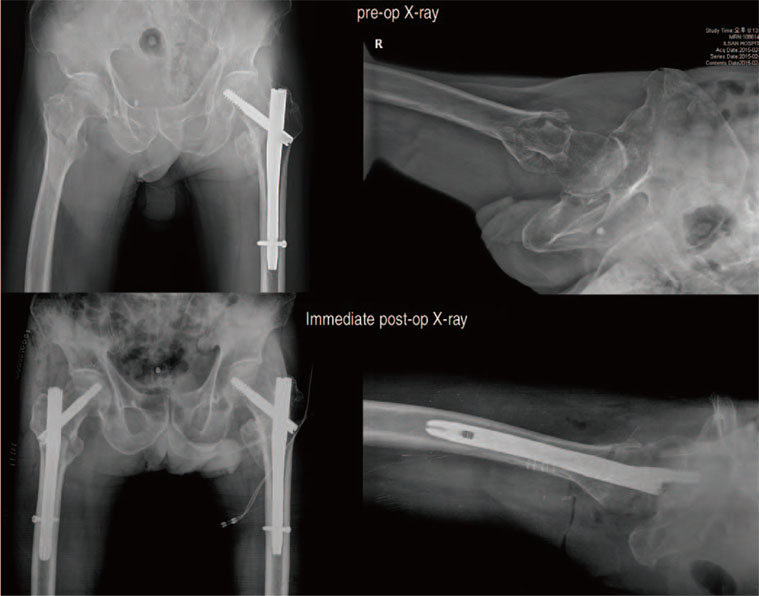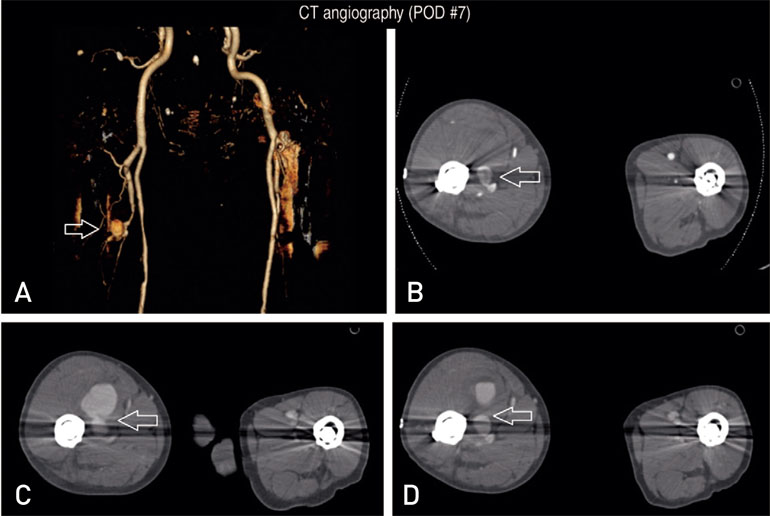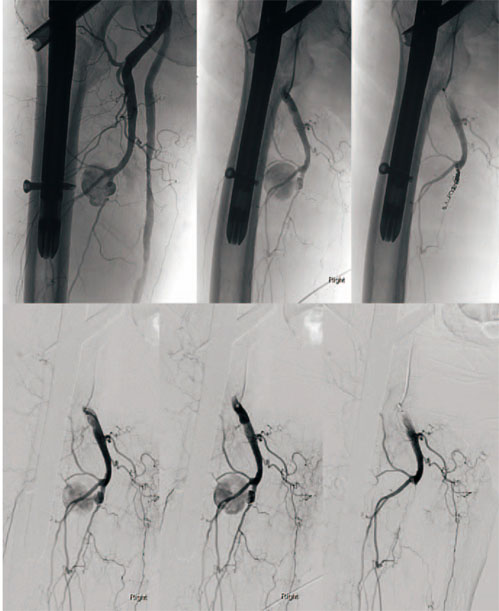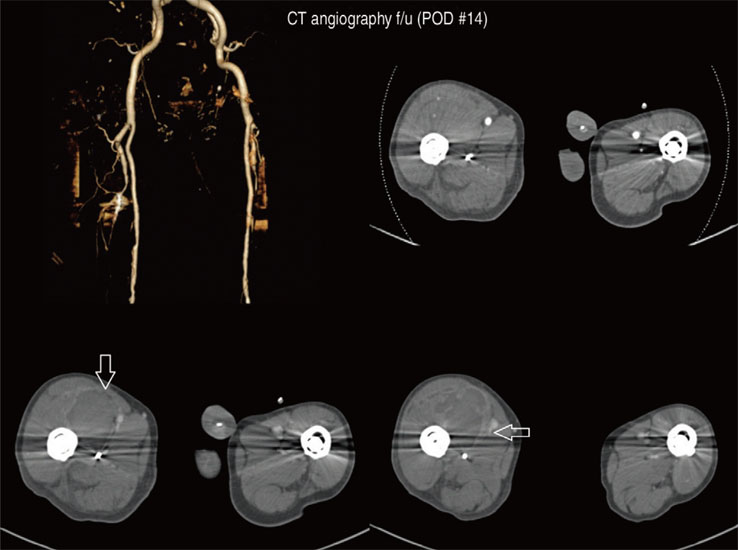Hip Pelvis.
2016 Mar;28(1):54-59. 10.5371/hp.2016.28.1.54.
Rupture of the Deep Femoral Artery during Proximal Femoral Nailing Following an Intertrochanteric Fracture: A Case Report
- Affiliations
-
- 1Department of Orthopedic Surgery, National Health Insurance Service Ilsan Hospital, Goyang, Korea. hyuncoh@hanmail.net
- 2Department of Diagnostic Radiology, National Health Insurance Service Ilsan Hospital, Goyang, Korea.
- KMID: 2161316
- DOI: http://doi.org/10.5371/hp.2016.28.1.54
Abstract
- Recently, we experienced a case where the diagnosis and management of a deep femoral artery rupture was delayed. This vascular complication occurred during the insertion of a distal interlocking screw of a proximal femoral nail for the fixation of an intertrochanteric femur fracture. A 79-year-old male patient was diagnosed with a right intertrochanteric fracture after a fall. We fixed the fracture with a proximal femoral nail (Zimmer® Natural Nailâ„¢ System). One day after the procedure, the patient complained of pain and swelling on the anteromedial side of his middle thigh followed by hypotension, anemia and prolonged thigh swelling. Computed tomography angiography was performed 7 days after the procedure. We found a pseudoaneurysm of the perforating artery caused by injury to the deep femoral artery and an intramuscular hematoma in the anterior thigh muscle. We successfully treated the pseudoaneurysm using coil embolization. Throughout the management of intertrochanteric femoral fractures, it is important to be aware and monitor signs and symptoms related to the possibility of blood vessel damage. When a patient presents with swelling and pain on the middle thigh and/or unexplained anemia postoperatively, the possibility that these symptoms are caused by an injury to the femoral artery must be considered.
MeSH Terms
Figure
Reference
-
1. Dameron TB Jr. False aneurysm of femoral profundus artery resulting from internal-fixation device (Screw). J Bone Joint Surg Am. 1964; 46:577–580.
Article2. Fordyce A. False aneurysm of the profunda femoris artery following nail and plate fixation of an intertrochanteric fracture. Report of a case. J Bone Joint Surg Br. 1968; 50:141–143.3. Park WR, Kang MS, Kim KT, Moon KP. Injury of the superficial femoral artery secondary to an unstable intertrochanteric fracture: a case report. Hip Pelvis. 2012; 24:338–341.
Article4. Singh S, Arora S, Thora A, Mohan R, Sural S, Dhal A. Pseudoaneurysm of profunda femoris artery following dynamic hip screw fixation for intertrochanteric femoral fracture. Chin J Traumatol. 2013; 16:233–236.5. Chan WS, Kong SW, Sun KW, Tsang PK, Chow HL. Pseudoaneurysm and intramuscular haematoma after dynamic hip screw fixation for intertrochanteric femoral fracture: a case report. J Orthop Surg (Hong Kong). 2010; 18:244–247.
Article6. Patelis N, Koutsoumpelis A, Papoutsis K, et al. Iatrogenic injury of profunda femoris artery branches after intertrochanteric hip screw fixation for intertrochanteric femoral fracture: a case report and literature review. Case Rep Vasc Med. 2014; 2014:694235.
Article7. Murphy PG, Geoghegan JG, Austin O, More-O'Ferrall R, Quinlan WR, Keaveny TV. Pseudoaneurysm of the profunda femoris artery due to intertrochanteric fracture of the hip. Arch Orthop Trauma Surg. 1999; 119:117–118.
Article8. Yang KH, Park HW, Park SJ. Pseudoaneurysm of the superficial femoral artery after closed hip nailing with a Gamma nail: report of a case. J Orthop Trauma. 2002; 16:124–127.
Article9. Grimaldi M, Courvoisier A, Tonetti J, Vouaillat H, Merloz P. Superficial femoral artery injury resulting from intertrochanteric hip fracture fixation by a locked intramedullary nail. Orthop Traumatol Surg Res. 2009; 95:380–382.
Article10. Yang KH, Yoon CS, Park HW, Won JH, Park SJ. Position of the superficial femoral artery in closed hip nailing. Arch Orthop Trauma Surg. 2004; 124:169–172.
Article11. Han CD, Lee YH, Yang KH, et al. Relationship between distal screws and femoral arteries in closed hip nailing on computed tomography angiography. Arch Orthop Trauma Surg. 2013; 133:361–366.
Article12. Chong KC, Yap EC, Lam KS, Low BY. Profunda femoris artery pseudoaneurysm presenting with triad of thigh swelling, bleeding and anaemia. Ann Acad Med Singapore. 2004; 33:267–269.13. Jindal R, Dhanjil S, Carrol T, Wolfe JH. Percutaneous thrombin injection treatment of a profunda femoris pseudoaneurysm after femoral neck fracture. J Vasc Interv Radiol. 2004; 15:1335–1336.
Article
- Full Text Links
- Actions
-
Cited
- CITED
-
- Close
- Share
- Similar articles
-
- Injury of the Superficial Femoral Artery Secondary to an Unstable Intertrochanteric Fracture: A Case Report
- Delayed Pseudoaneurysm of Deep Femoral Artery Caused by Migration of Lesser Trochanter, Subsequent to an Intertrochanteric Fracture Surgery - A Case Report -
- Comparison of Femoral Morphology and Bone Mineral Density between Femoral Neck Fractures and Trochanteric Fractures in 65+ Females
- Delayed Femoral Neck Fracture in Interlocking Intramedullary Nailed Femur: A case report
- Excessive Sliding of the Helical Blade and the Femoral Neck Fracture after Insertion of Proximal Femoral Nail Anti-Rotation for Type A2 Intertrochanteric Fractures - A Case Report -





